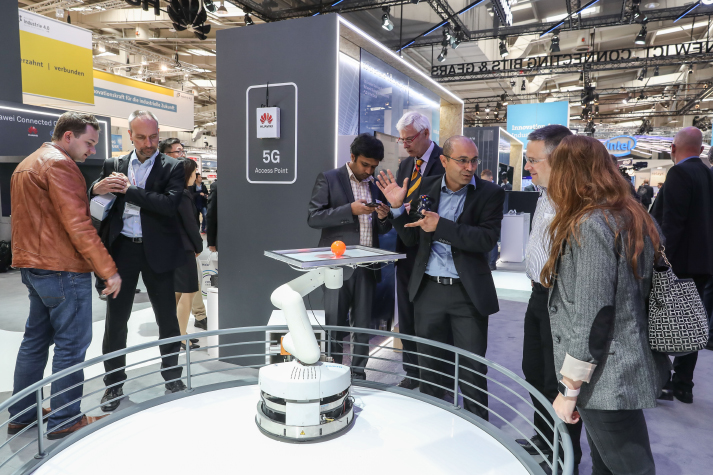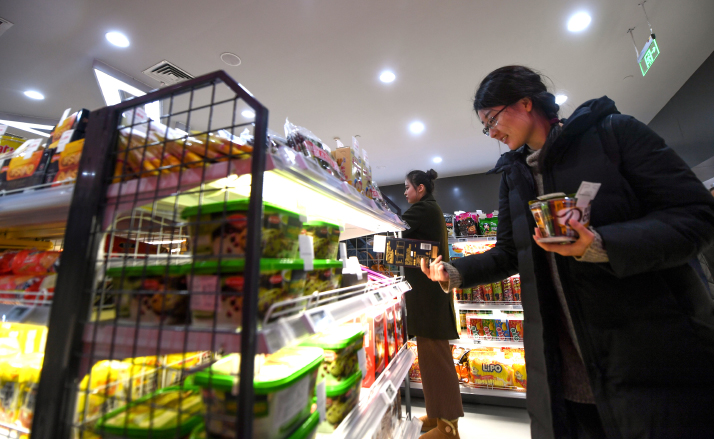| Business |
| Feeding Evolution | |
| The Internet of Things is changing the way people live and work | |
|
|
 People watch 5G-technology manipulated robots at the Hanover Fair in Germany on April 24 (XINHUA)
As environmental protection continues to top the Chinese Government's agenda in recent years, many local departments are employing real-time monitoring and control to pinpoint and tackle sources of pollution. "Different types of sensors are placed in possible pollution sources like industrial parks and construction sites. Once the concentration of discharged pollutants is beyond the accepted limits, environmental supervisors are informed and provided with data, videos and solutions. They are then able to identify specific targets and take action to eliminate pollution," said Huang Song, who works for a company that provides such services to local environmental protection bureaus, construction committees and city management bureaus. The young man joined Grand Science & Technology three years ago and has witnessed its rapid expansion based on the robust development of the Internet of Things (IoT) industry in China. "When it was first established a few years ago, the company had a small staff. Now, it is based in a dozen cities and has more than 100 employees," Huang told Beijing Review, suggesting that increasingly advanced IoT technologies have significantly improved the efficiency of environmental monitoring and pollution control.  Customers select goods at a JD.com staffless store in Tianjin on January 18 (XINHUA)
Ready for takeoff This is just an example of IoT application in human society. McKinsey & Company, a worldwide management consulting firm, estimates IoT application could have a total economic impact of $3.9 trillion to $11.1 trillion per year by 2025. IoT, a term used to describe the use of sensors and other Internet-connected devices to track and control physical objects, has blazed new ways of doing business. Things ranging from smart bracelets and shared bicycles to self-service stores and smart cities, are all feeding off IoT technologies, secretly infiltrating into daily life and work. According to a study by Gartner, a global research and consulting company, IoT is not a new technology anymore since it has gradually integrated into living and production activities. For example, there are more than 320 million IoT connections in China, most of which are realized through wide-area networks, while the number of connections through local-area networks is even larger, according to public data released by domestic telecom operators. "These connections have opened up new space for enterprises residing upstream or downstream of the IoT industrial chain, creating new value for IoT users in various sectors," said Zhao Xiaofei, CEO of IoT101, a think tank focused on information services for IoT companies, in an interview with Beijing Review. By connecting non-intelligent objects, collecting related data through these connections and sending the information to a platform for analysis, people can find solutions and further improve the objects, Zhao explained. The concept of IoT first came into the spotlight in 2009, when then Chinese Premier Wen Jiabao made a speech in the city of Wuxi, east China's Jiangsu Province, calling for rapid development of IoT technologies. At the time, however, it was just a hot topic without any real advancement. From 2009 to 2011, rapid progress was made in the development of radio frequency identification. By 2013, smart home and intelligent hardware began to sprout and become fashionable in the Chinese market. "It was when low-power wide-area networks became available in the past two years that real ground was broken in IoT application," said Zhao, noting that the explosive growth of IoT application lies in great demand from various industries. According to a survey conducted by Hewlett-Packard, 57 percent of the 3,100 respondent companies have employed IoT technologies, and 88 percent of them said that IoT projects feature fast investment return. In another survey conducted by Vodafone in late 2017, enterprises equipped with more IoT devices witnessed a higher yield rate. Some 67 percent of companies with over 50,000 devices connected through IoT suggested that they made considerable profits from IoT application, contributing over 19 percent to their revenue growth on average. Persisting challenges Zhao categorized the industry into consumer IoT and industrial IoT. "Obviously, the latter develops at a faster pace than the former. The popularization of the former depends on user experience and the latter on the generated economic value," he said. Zhao said the user experience of IoT products is not good enough to attract large numbers of consumers yet because related technologies like artificial intelligence (AI) are not mature enough or have not been fully incorporated into products. He also said some manufacturers are too focused on being intelligent and are ignoring the quality and basic functions of products. "Some IoT products are so complicated to operate that consumers tend to put aside their intelligent functions and use them as common ones," Zhao said. Industrial IoT, on the other hand, has registered rapid growth in recent years. "Many enterprises have really benefited from it and thus are willing to pay for it, but there are still obstacles in its path to popularization," Zhao noted. Some companies already have an information infrastructure system in place and don't want to disrupt or restructure it due to greater costs. Furthermore, industrial IoT application means a smaller workforce is needed, which may lead to large numbers of layoffs, said Zhao, citing intelligent meter reading as an example. As water supply companies use meters which can send data automatically, many meter readers have lost their jobs. In addition, IoT security has become an increasingly glaring problem. As attacks targeting IoT increase, regulators are applying more pressure on equipment manufacturers to formulate and carry out higher network stabilization assessment standards. Gartner estimated total expenditures on cybersecurity may reach $93 billion in 2018, while General Motors suggested that industrial IoT is more likely to be under threat and effective tools to handle such risks are not yet available. Moreover, there are no uniform IoT technical standards, making it difficult to lower hardware costs. Future growth In April 2017, China's Ministry of Industry and Information Technology unveiled a plan on IoT development for the 13th Five-Year Plan (2016-20) period. A target was set to foster a globally competitive IoT industrial system by 2020, with the total industrial output surpassing 1.5 trillion yuan ($226 billion). "Now, there is a complete IoT industrial ecosystem in China, and in each segment there are numerous companies," said Zhao, adding that in the past few years, market players have been reluctant to apply AI due to its underdeveloped technological level, but now, the situation is changing. Some experts believe that the development of IoT devices will be further quickened by technologies such as machine learning, block chain and fuzzy computation, which will help enterprises transform from creating added value to inventing new business models and tapping into new income sources. When enterprises are rewarded with a sizable return on their investment, IoT application will in turn be further fueled. "Though Chinese companies lag behind their international rivals in sensor and chip technologies, the vast domestic market is nutritious soil to nurture different types of IoT application, which spurs the industry on," said Zhao. Copyedited by Rebeca Toledo Comments to dengyaqing@bjreview.com |
|
||||||||||||||||||||||||||||
|